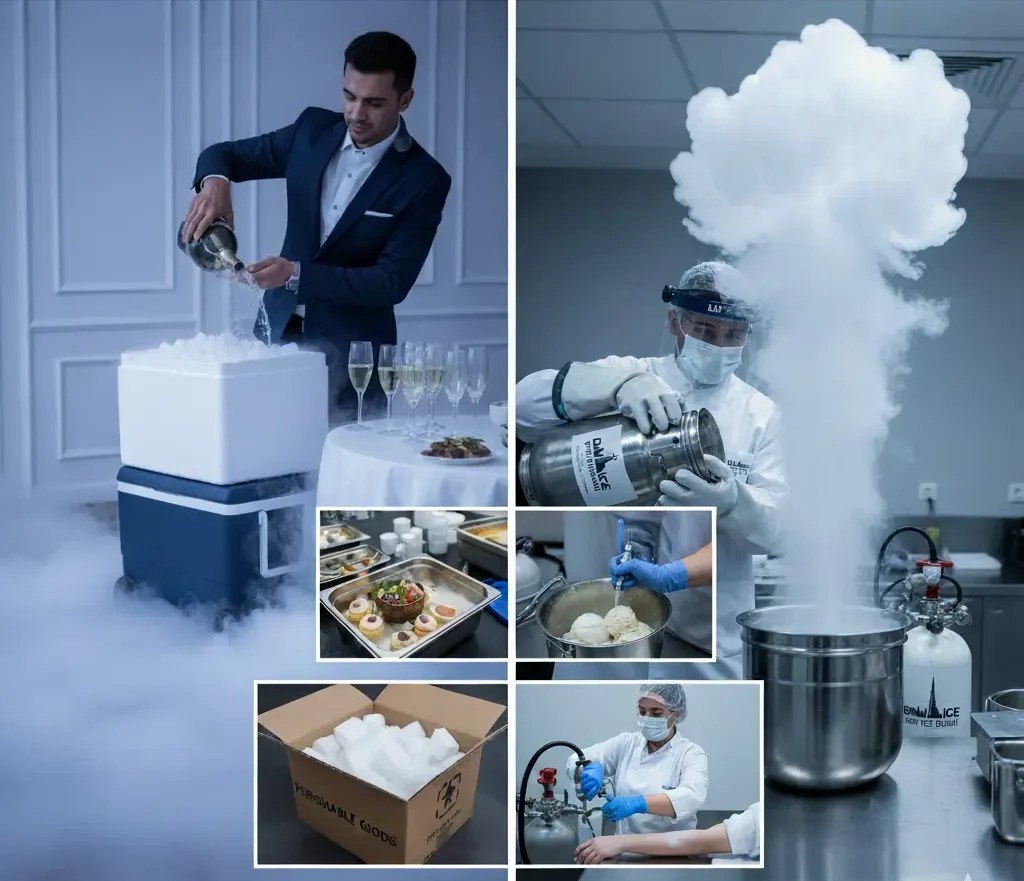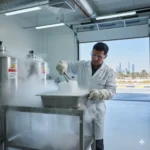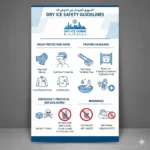Are you working with extreme temperatures, or perhaps planning a truly spectacular event? You’ve likely heard of both dry ice and liquid nitrogen – two powerful cryogenic agents known for their incredible cooling capabilities. But while they both create dramatic fog effects and maintain ultra-low temperatures, they are far from the same. Misunderstanding their differences can lead to anything from inefficient results to serious safety hazards.
At Dry Ice Dubai, your trusted supplier for dry ice and cryogenic solutions across the UAE, we often encounter questions about these fascinating substances. This guide will cut through the confusion, explaining precisely what dry ice and liquid nitrogen are, how they differ, and which one is the right choice for your specific needs.
What is Dry Ice? The Solid Form of Cooling
Dry ice is simply the solid form of carbon dioxide (CO₂). Unlike regular ice, which melts into water, dry ice undergoes a process called sublimation – it turns directly from a solid into a gas (CO₂) without passing through a liquid phase. This unique property, along with its extremely cold temperature, makes it a highly versatile cooling agent.
Key Characteristics & Properties of Dry Ice:
- Temperature: Sublimates at -78.5°C (-109.3°F).
- Appearance: Solid white, odorless, non-flammable.
- Composition: Solid carbon dioxide (CO₂).
- Safety: Requires proper ventilation to avoid CO₂ buildup, which can displace oxygen. Direct skin contact can cause frostbite.
- Availability: Typically available in blocks, pellets, or slices.
Common Uses of Dry Ice:
- Food Preservation & Shipping: Ideal for keeping perishable food items, frozen goods, and beverages chilled during transport, catering, or camping.
- Medical & Pharmaceutical Transport: Crucial for maintaining ultra-low temperatures for vaccines, biological samples, and organs.
- Special Effects: Creates stunning, low-lying fog for events, concerts, theatre productions, and Halloween parties.
- Industrial Cleaning (Dry Ice Blasting): Fine dry ice pellets are propelled at high speed to clean surfaces, removing dirt, grease, paint, and contaminants without moisture or abrasive damage.
- Emergency Refrigeration: A reliable backup for freezers during power outages.
What is Liquid Nitrogen? The Ultra-Cold Cryogen
Liquid nitrogen (LN₂) is nitrogen gas (N₂) in its liquid state. It’s produced by cooling atmospheric air to extremely low temperatures until it liquefies. Nitrogen makes up about 78% of the air we breathe, but in its liquid form, it’s a powerful cryogen.
Key Characteristics & Properties of Liquid Nitrogen:
- Temperature: Boils at -196°C (-320.8°F), making it significantly colder than dry ice.
- Appearance: Clear, odorless, non-flammable liquid that rapidly boils when exposed to warmer temperatures, creating a dense vapor cloud.
- Composition: Liquid diatomic nitrogen (N₂).
- Safety: Due to its extreme cold, direct contact causes severe frostbite instantly. Requires specialized cryogenic containers for storage and handling. Rapid vaporization in enclosed spaces can quickly deplete oxygen, posing an asphyxiation risk.
- Availability: Stored and transported in specialized vacuum-insulated dewars or tanks.
Common Uses of Liquid Nitrogen:
- Medical & Research: Used for cryopreservation of biological samples (sperm, eggs, embryos), removal of skin lesions (cryotherapy), and cooling scientific equipment.
- Industrial Processes: Applications in metal treatment, shrink-fitting, grinding, and electronics manufacturing.
- Food & Beverage: Flash freezing food items, creating instant ice cream, or rapid chilling of ingredients in molecular gastronomy.
- Veterinary Science: Artificial insemination and storing animal tissues.
Dry Ice vs. Liquid Nitrogen: The Crucial Differences
While both are essential in cryogenic applications, their distinctions are critical for safe and effective use.
| Feature | Dry Ice (Solid CO₂) | Liquid Nitrogen (LN₂) |
|---|---|---|
| Chemical Formula | CO₂ (Solid Carbon Dioxide) | N₂ (Liquid Nitrogen) |
| Temperature | -78.5°C (-109.3°F) | -196°C (-320.8°F) |
| State at Room Temp | Sublimes (solid to gas) | Boils (liquid to gas) |
| Handling | Gloves required, good ventilation essential | Cryogenic gloves, face shield, specialized protective gear; extreme caution with ventilation |
| Storage | Insulated containers (e.g., polystyrene boxes) | Specialized vacuum-insulated dewars or cryogenic tanks |
| “Fog” Effect | Dense, low-lying fog (CO₂ gas mixed with water vapor) | Dense vapor cloud (nitrogen gas + water vapor), disperses more quickly |
| Residue | No liquid residue | No liquid residue (vaporizes completely) |
| Primary Risk | Suffocation (CO₂ displaces oxygen), frostbite | Extreme frostbite, asphyxiation (N₂ displaces oxygen) |
| Contact with Water | Creates fog and speeds sublimation | Rapidly boils, creating large vapor clouds |
Which One Should You Choose?
The choice between dry ice and liquid nitrogen depends entirely on your specific requirements:
- For General Cooling & Preservation: If you need to keep items frozen or very cold for extended periods, or for applications like special effects fog, dry ice is usually the more practical and safer option. It’s easier to handle, requires less specialized equipment, and offers effective cooling within a manageable temperature range.
- For Ultra-Low Temperatures & Flash Freezing: If your application demands extremely low temperatures (below -100°C), rapid freezing, or precise cryopreservation, liquid nitrogen is the only choice. However, this comes with significantly higher safety precautions and specialized handling equipment.
Partner with Dry Ice Dubai for Safe & Reliable Cryogenic Solutions
Whether you need the consistent cooling power of dry ice or the ultra-cold capabilities of liquid nitrogen, Dry Ice Dubai is your trusted partner. With over 20 years of experience, we provide:
- Certified Quality: Food and medical-grade dry ice, and high-purity liquid nitrogen.
- Comprehensive Range: Dry ice in blocks, pellets, slices, and liquid nitrogen with specialized tanks.
- Unparalleled Expertise: Our team advises on the best product for your application and ensures safe handling and delivery.
- Reliable Delivery: Same-day dry ice delivery in Dubai, and efficient service across the UAE for all cryogenic needs.
Don’t compromise on quality or safety. Contact Dry Ice Dubai today for all your dry ice and liquid nitrogen requirements.
Frequently Asked Questions (FAQs)
What are the main temperature differences between dry ice and liquid nitrogen?
Dry ice maintains a temperature of -78.5°C (-109.3°F) as it sublimes. Liquid nitrogen is much colder, boiling at -196°C (-320.8°F).
Is one safer to handle than the other?
Both require extreme caution. Dry ice carries risks of frostbite and asphyxiation from CO₂ buildup. Liquid nitrogen, being significantly colder, poses a more immediate and severe frostbite risk and can displace oxygen more rapidly, leading to asphyxiation. Specialized protective equipment is mandatory for both, with liquid nitrogen requiring more advanced gear.
Can I use dry ice for flash freezing food?
Dry ice can freeze food, but liquid nitrogen provides true “flash freezing” due to its much lower temperature, resulting in smaller ice crystals and better preservation of texture and flavor. For most home or catering flash freezing, dry ice is sufficient, but for commercial-grade flash freezing, LN₂ is superior.
Do Dry Ice Dubai supply both dry ice and liquid nitrogen?
Yes, Dry Ice Dubai is a leading supplier of both premium-quality dry ice (blocks, pellets, slices) and high-purity liquid nitrogen, along with suitable storage tanks, for various industrial, medical, and event applications across the UAE.
What kind of containers are needed for dry ice and liquid nitrogen?
Dry ice should be stored in insulated containers (like polystyrene boxes or ice chests) that allow for CO₂ gas to vent. Liquid nitrogen requires specialized, vacuum-insulated cryogenic dewars or tanks to minimize boil-off and maintain its extreme cold temperature.
What are the primary safety concerns when using either product?
For both, the main concerns are frostbite from direct contact and asphyxiation in poorly ventilated areas due to the rapid displacement of oxygen by the gas (CO₂ from dry ice, N₂ from liquid nitrogen). Always use appropriate personal protective equipment (PPE) and ensure ample ventilation.






